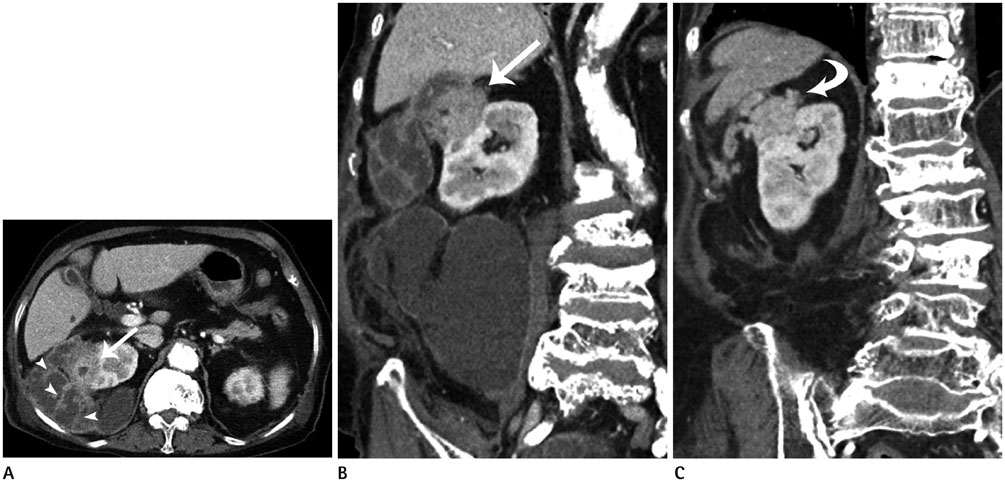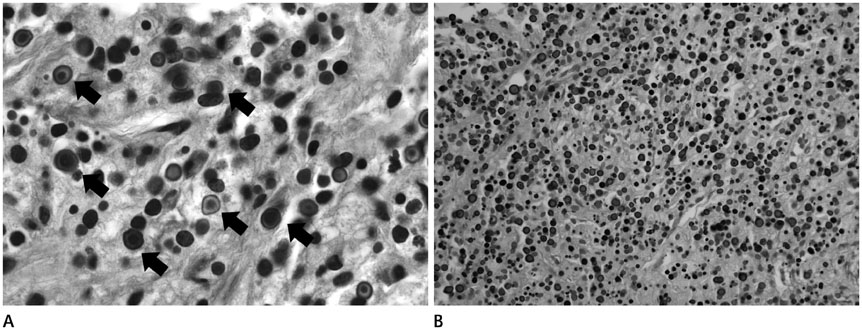J Korean Soc Radiol.
2015 Jul;73(1):62-65. 10.3348/jksr.2015.73.1.62.
Renal Malakoplakia with Wide Extension into the Retroperitoneum: A Case Report
- Affiliations
-
- 1Department of Radiology, Anam Hospital, College of Medicine, Korea University, Seoul, Korea. urorad@gmail.com
- 2Department of Pathology, Anam Hospital, College of Medicine, Korea University, Seoul, Korea.
- KMID: 1823926
- DOI: http://doi.org/10.3348/jksr.2015.73.1.62
Abstract
- Malakoplakia is a rare chronic inflammatory condition that results from defective phagolysosomal activity. Malakoplakia usually affects the urinary tract, and immunosuppression is a predisposing factor in most patients. A 78-year-old woman undergoing long-term steroid treatment presented with right flank pain. CT demonstrated a large, multilocular cystic mass with focal enhancing solid portion in the right kidney and retroperitoneum. The patient underwent ultrasonography-guided biopsy for enhancing the solid portion, and pathologic examination revealed malakoplakia.
MeSH Terms
Figure
Reference
-
1. Wielenberg AJ, Demos TC, Rangachari B, Turk T. Malacoplakia presenting as a solitary renal mass. AJR Am J Roentgenol. 2004; 183:1703–1705.2. Radin DR, Siskind B, Weiner S, Bernstein R, Ziprkowski M. Retroperitoneal malacoplakia. Urol Radiol. 1984; 6:218–220.3. Zimina OG, Rezun S, Armao D, Braga L, Semelka RC. Renal malacoplakia: demonstration by MR imaging. Magn Reson Imaging. 2002; 20:611–614.4. Kajbafzadeh A, Baharnoori M. Renal malakoplakia simulating neoplasm in a child: successful medical management. Urol J. 2004; 1:218–220.5. Yoon SY, Lee HJ, An JH, Kim SJ, Kim SW, Woo JH, et al. Renal parenchymal malakoplakia presenting with abscesses and hepatic extension misdiagnosed as a malignant tumor: a case report. Korean J Med. 2012; 82:764–768.6. Cury J, Coelho RF, Franco M, Srougi M. Renal parenchymal malacoplakia with pleural effusion. Clinics (Sao Paulo). 2007; 62:87–88.7. Dharmadhikari R, Crisp A. Sequential changes in sonographic appearances of childhood renal malakoplakia progressing to end-stage renal failure. J Ultrasound Med. 2006; 25:1219–1222.8. Kamishima T, Ito K, Awaya H, Mitchell DG. MR imaging of bilateral renal malacoplakia after liver transplantation. AJR Am J Roentgenol. 2000; 175:919–920.
- Full Text Links
- Actions
-
Cited
- CITED
-
- Close
- Share
- Similar articles
-
- Renal Malakoplakia with Secondary Hepatic Extension: A Case Report
- Pulmonary Malakoplakia Associated with Peripheral Cysts in an Immunocompetent Patient: A Case Report
- Renal Parenchymal Malakoplakia Presenting with Abscesses and Hepatic Extension Misdiagnosed as a Malignant Tumor: A Case Report
- Renal Parenchymal Malakoplakia with Acute Interstitial Nephritis Presented with Acute Kidney Injury
- Malakoplakia in a Renal Allograft: A case report



